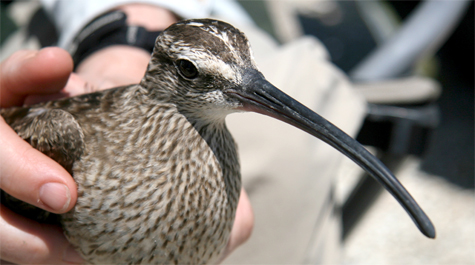Far-flying Hope the whimbrel arrives at her breeding grounds
Hope the whimbrel has arrived safe at her Arctic breeding grounds. The Center for Conservation Biology has tracked the spring and fall migrations of Hope for three years after she was captured on May 19, 2009 on the Eastern Shore and fitted with a solar-powered satellite transmitter.
Bryan Watts, director of the Center for Conservation Biology (CCB), explained that Hope, like other whimbrels, makes long migration flights, shuttling back and forth from her wintering spot at Great Pond, on St. Croix in the U.S. Virgin Islands, to breeding grounds on the upper Mackenzie River in the far northwest of Canada.
Hope touched down in a marsh near Box Tree Creek on Virginia’s Eastern Shore on April 8. Watts said that she uses the area as “staging grounds” on her way north, resting and feeding on fiddler crabs to recharge her batteries for the remainder of the 3,700-mile trip to the breeding grounds.
The bird left the Eastern Shore on May 22, arriving at the breeding grounds on June 14. The CCB is tracking other whimbrels as well. Updated tracking maps are available online.
Hope made ornithological history two years ago as being the first whimbrel to be tracked over a full migration cycle. Her arrival in Canada marks the third full migration cycle that CCB scientists have tracked.
“Satellite tracking represents only one aspect of a broader, integrated investigation of whimbrel migration,” Watts said. During the past four years, the CCB has partnered with The Nature Conservancy, the U.S. Fish and Wildlife Service and the Georgia Department of Natural Resources in a number of initiatives to learn more about the birds. Watts said the collaborators have used conventional transmitters to examine stopover duration, conducted aerial surveys to estimate seasonal numbers, collected feather samples to locate summer and winter areas through stable-isotope analysis, and initiated a whimbrel watch program.
Through these efforts, scientists have learned a great deal about whimbrels, whose migratory habits were shrouded in mystery for years. One important revelation, Watts said, is the site-specific nature of the whimbrel’s habits. Hope’s life cycle centers around a total land mass of probably a few hundred acres, but each of the three locations are vital—and possibly irreplaceable.
“It might be that entire populations depend on relatively few sites. So if you have a major impact to one of those, it could be more devastating than we realize. If Great Pond were to be eliminated, the birds that winter there would have to go elsewhere, or maybe they’d die out,” Watts explained. “Connecting the dots throughout an entire life cycle is something that’s new and just coming over the horizon in the study of migratory birds—the connectivity of places that are separated by such great distances.”
The Center for Conservation Biology is a collaborative unit of the College of William & Mary and Virginia Commonwealth University.
 Skip to main content
Skip to main content

